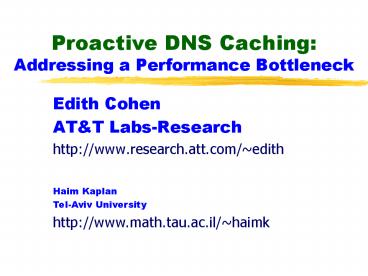Proactive DNS Caching: Addressing a Performance Bottleneck - PowerPoint PPT Presentation
1 / 29
Title:
Proactive DNS Caching: Addressing a Performance Bottleneck
Description:
DNS lookup (address to name) TCP connection setup. Server processing time / reverse DNS (access control) Transmission time. Request-response RTT ... – PowerPoint PPT presentation
Number of Views:69
Avg rating:3.0/5.0
Title: Proactive DNS Caching: Addressing a Performance Bottleneck
1
Proactive DNS CachingAddressing a Performance
Bottleneck
- Edith Cohen
- ATT Labs-Research
- http//www.research.att.com/edith
Haim Kaplan Tel-Aviv University http//www.math.ta
u.ac.il/haimk
2
Talk Overview
- Overview and Motivation
- DNS architecture
- effect of DNS lookup latency
- Proactive DNS caching
- Renewal Policies
- Simultaneous Validation
- Conclusion
3
Domain Name System
hostname
IP-address
www.research.att.com
135.207.23.30
- Essential for Internet name-based communication
- Many-to-many mapping (virtual hosting, mirrors,
aliases) - Distributed database maintained by a hierarchy of
name-servers
4
DNS Hierarchy
5
DNS Lookup
Client
- Root DNS server
- returns NS for att.com
- dnsprime.att.com
- returns NS for research.att.com
- ns0.research.att.com
- returns IP-address for www.research.att.com
root
dnsprime.att.com
ns0.research.att.com
6
Resolving Hostnames
- Browser if no answer in browser cache, query is
sent to the local DNS server. - Name-server use own cache. For missing info,
iteratively query remote name-servers, while
following referrals/ delegations.
7
DNS Caching Mechanism
- Data is stored in Resource Records (RR)
(NS, A, CNAME, SOA) - Each record has a TTL value (Time To Live)
- TTL values are assigned by respective domain
administrators. - Record may be cached and used only for TTL
duration.
8
Latency Effect of DNS Lookups
All requests gt 60 sec after previous, ATT log
9
Latency Effect of DNS Lookups (2)
AltaVista referrals requests, ATT proxy log
10
Performance effect...
- NLANR cache service times on AKAMAI servers
a4,a111.g.akamaitech.net
11
Service Times DistributionURLs served by
a4.g.akamaitech.net
0 to 3 seconds
7351 requests in 6 days, 90lt200ms, 95 lt 500ms
12
Issues with DNS Latency
- RTTs to (several) remote name servers
- Not addressed by fatter pipes, faster
high-capacity content servers. - Highly sensitive to packet loss
- Inconsistent - fraction of lookups suffer
long/pathological delays - As Internet service improves, will increasingly
become more noticeable.
13
Before DNS DNS
one hosts.txt file centrally maintained ftpd
where needed
Hierarchy of distributed name-servers.
- no lookup delay (data is available locally)
- scalability problems
- growing database size
- coherence
- single point of failure/load
- Scalable robust
- distributed control
- distributed presence
- lookup delays from remote queries
14
Passive DNS caching
Used by BIND name-server software
- Query remote NS only to answer a current client
request - Cache (use) results till TTL expires
15
Proactive DNS caching
Guidelines
Respect TTL values (be transparent to
client) Minimize overhead to DNS servers
Our Proposals
- Renewal Policies
auto-refresh entries just before TTL expires - Simultaneous Validation
Concurrently validate use
expired address
16
Methodology and Logs
- Proxy logs
- Simulate associated DNS cache
- Separately issued DNS queries to obtain TTL
values, rate-of-change of IP-address.
17
Performance of Passive caching
18
Renewal Policies
- Issue a renewal query upon expiration. - Policy
determines when to renew. - Tradeoff of
overhead/reduced-latency.
- R-LRU renew r times passed the most-recent cache
hit - R-LFU grant r additional renewals per hit ( TTL
interval) - R-FIFO grant r renewals at entry time to the
cache - R-OPT optimal omniscient offline renewal policy
19
Performance of Renewal Policies
ATT proxy log
20
Performance of Renewal Policies
UC (NLANR) log
21
Renewal Policies Conclusions from Experiments
- R-LRU and R-LFU performed equally well across
logs - R-FIFO did not perform as well
- Reduction in misses corresponds to reduction in
long DNS query times - More effective for more clients
22
Renewal Policies Implementation and Extensions
- Most natural Implementation is within the
name-server - Overhead control
- Pre-expiration renewals (usually 1 RTT)
- off-peak renewals
- Policies can be adapted to account for varying
DNS resolution times
23
TTL versus Rate-of-change
- TTL values are set conservatively Rate-of-change
of addresses is significantly lower than TTL
value. - So, when expired records are discarded, we
often loose valuable and valid information
24
Simultaneous Validation
- Keep expired address records.
- When a client request arrives, concurrently
- Initiate a connection to host, using expired
IP-address, and start fetching content - Issue a validating DNS query
- If validation is successful, serve the content to
the client
25
SV Latency Gain
Client
DNS
- DNS lookup
- session with Web server
- Establishing TCP connection(s), sending HTTP
request(s), ...
26
Simultaneous Validationsuccess rate
27
Simultaneous ValidationImplementation Choices
- browser or proxy (with a separate DNS cache)
- requires maintenance of a separate
name-to-address cache - single-entity implementation
- name-server (using its internal cache)
- requires protocol support for 2-phase resolutions
- requires separate proxy or browser support
- SV is more effective for a larger user base.
28
Summary
- DNS lookup delays can be addressed by increasing
local availability of RRs - Renewal Policies
- incur overhead of additional queries
- simple limited deployment is effective
- inter-request-time lt c TTL
- Simultaneous Validation
- minimal overhead
- more involved implementation
- inter-request-time lt IP-address-lifetime
29
Future Work
- Single, replicated, hostname database SV
- Co-operative DNS caching
- Distributed local name server
- SV and Renewal at the RR level
- Collect better data name-server logs combined
with logged HTTP requests - Refreshment policies for Web content































